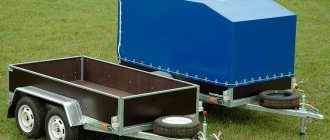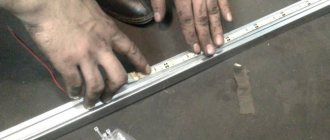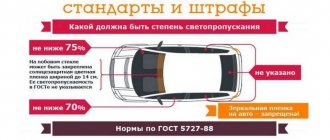The only problem for many car enthusiasts is the high cost of gasoline and diesel fuel for their cars. Indeed, the price market for fuel and lubricants is steadily growing upward every year, and for many people, constantly refueling their car with expensive fuel is beginning to become not a necessity, but a luxury.
- HBO 4 generations. Video:
- Installation features
- Why should you trust professionals?
- How to register HBO with the traffic police?
Therefore, installing gas equipment on a car is an excellent solution for many car enthusiasts. It sounds surprising, but you can install gas equipment in your car yourself. After all the procedures, it is necessary to carry out mandatory system registration and other actions, which will be discussed in more detail below.
Pros and cons of installing HBO
Switching a car to gas fuel is a rather serious and responsible step that must be approached with full responsibility. The pros and cons of installing and using gas equipment should be considered.
The advantages include:
- First of all, this is saving your personal funds. This is the main reason for switching a car from gasoline (diesel) to gas fuel. On average, annual prices for purchasing gas for a car are 35-40% cheaper than gasoline.
- The peculiarity of gas from gasoline is its high octane number of 100 or more. As a result, you will observe more “stable” operation of the power unit of your car. Gas does not put such a high load on the cylinder-piston group as gasoline, and as a result, uniform combustion of the fuel.
- Extending the service life of auto spark plugs. This is achieved due to the fact that the gas does not leave residues during combustion, thereby not “clogging” the electrodes of the spark plugs. As a result, the service life of the candles is doubled.
- Also an important advantage of using gas-cylinder equipment is the doubling of the service life of the engine oil. The gas mixes evenly with the air flow and thus does not wash away the oil protection from the surface. As a result, the oil will retain its performance qualities much longer and the personal costs of purchasing it will be reduced.
- Environmental friendliness of HBO. As mentioned above, gas is a natural product that burns without leaving any residue. Therefore, car exhaust gases will no longer contain harmful elements such as sulfur or various additives.
- Convenience and practicality of using gas equipment in cars. Modern gas equipment is able to switch to the required type of fuel using a toggle switch.
- And the last important advantage is low fire and explosion safety. You should not believe rumors and various stereotypes. If there is mechanical damage or various cracks, the fuel will begin to cool quickly, turn into a gaseous state and evaporate. And in the winter season, the chances of gas ignition are almost zero.
But we should also not forget about the disadvantages of using HBO:
- The first disadvantage is the sheer size of the gas equipment. The size of the gas cylinder will occupy on average half of the luggage compartment of the car. This, in turn, will not appeal to those motorists who like to travel or transport cargo in passenger cars. You should immediately choose between comfort or saving personal funds.
- Since gas burns slowly, the next disadvantage of using gas equipment is noticeable, namely the loss of power. On average, a car loses about 10%. But the power is replaced by smooth motion control without unwanted jerks of the car.
- The next disadvantage is the high load on the valves. This increases their risk of heating up, leading to overload. Therefore, when using HBO in a car, you should not abuse the operation of the car at high speeds.
- Costs for installation and registration of gas equipment. Registration of gas equipment must go through a lot of paperwork and be included in the vehicle registration certificate.
- The relative high cost of repairing gas equipment.
After weighing all the advantages and disadvantages of the presented system and the features of its use, it is recommended to make the right choice.
HBO in a car. Video:
Which models should you install HBO on?
If we list the best machines for installing gas equipment, this list will be large. In particular, gas-cylinder equipment can be installed on all cars with conventional engines (except for those on which the system cannot be installed). This category includes both domestic cars and products of the foreign automobile industry.
If we talk about cars imported from America, almost everything can be equipped with LPG. The following models are most suitable for this:
- Ford Fusion;
- Toyota Camry;
- Honda Civic;
- Volkswagen Jetta;
- Hyundai Elantra;
- Kia Optima Hybrid;
- Jeep Cherokee;
- Nissan Rogu;
- Mitsubishi Outlander;
- Hyundai Tucson.
If you wish, you can contact a service station that installs gas equipment and find out whether it is possible to install LPG on the car or not. If this cannot be done, they will definitely tell you.
Now you know which cars you can and cannot install HBO on. In the comments, share your experience and recommendations regarding system installation.
Generations of HBO, choosing equipment for your car
Now it’s worth approaching the important issue of choosing generations of HBO. It is recommended to consider all existing generations.
There are five generations of HBO in total: from relatively old to the most modern systems, which are discussed in detail:
1. Distinctive features of the first generation are the presence of a gas evaporator (separation-type gear system). Its use began in the 90s of the last century. Currently, these systems are old, and they have been replaced by the second generation of gas equipment. But most car enthusiasts and gas equipment installers consider them to be very reliable.
2. A feature of the second generation of gas equipment is the manual supply of fuel using a specific tube with a hole inside. The diameter of the hole in the dispenser directly depends on the bolt screwed transversely into it. The more it is screwed in, the less gas fuel is supplied. The disadvantage of this generation of gas equipment is the need to adjust the cross-section in case of contamination of the air filter.
3. The third generation of gas equipment uses a gas supply system through a special dispenser. In other words, fuel is supplied directly from a special motor, which is powered by the vehicle’s on-board system. Accordingly, the main advantage of the third generation of HBO is its configuration via a PC.
4. The fourth generation of gas equipment made a breakthrough in mechanical engineering with its production. Its main and important feature from previous generations is the supply of fuel from the gearbox to the injectors of the power unit. Due to this, an ideal gas supply occurs, which in its characteristics is not inferior to its “gasoline” competitors. The “brain” of this system is configured exclusively through a computer or laptop.
5. The fifth generation of gas equipment did not find high popularity among car enthusiasts in the CIS countries. Since its operation is possible only through the installation of a certain high-pressure pump, which is installed in the inside of the cylinder. And also due to the low quality of liquefied gas necessary for its operation. The advantage of this generation of gas equipment is the injection of gas directly into the combustion chamber of the vehicle.
The choice of system is approached not only taking into account convenience, but also with a preliminary examination of the technical characteristics of the car. The most preferable option should be selected in accordance with the capabilities of the vehicle.
HBO 4 generations. Video:
The installation procedure for gas cylinder equipment when installing it on a car
After selecting gas equipment, you can begin installing it in the car. See detailed video instructions for installing 4th generation gas equipment below.
Before starting the installation, you need to decide on the mounting locations for the filling valve (usually under the bumper or in the area of the gas tank filler neck) and the fuel switch button (gas/petrol) in the car interior.
During the installation of gas equipment, the battery must be disconnected from the vehicle's on-board network!
The first element of gas equipment that is installed on a car is a gas reducer . Its task is to reduce gas pressure and maintain constant pressure at the outlet of the reducer. The gearbox itself is mounted on fixed and stable elements in the engine compartment.
Then rubber hoses are connected to it, through which antifreeze is supplied from the engine cooling system to heat the gearbox during operation. In most cars, the connection to the cooling system should be in parallel, that is, between the engine block and the heater radiator (the so-called small circle).
Features of installing gas equipment that everyone needs to know about
Next, we should consider the features of installing gas equipment in a car, which undergoes annual changes both in terms of technical data and legal and financial factors.
Installation features
First of all, the cost of installing gas equipment on a vehicle directly depends on the following factors:
- Engine mileage, volume and power.
- Number of cylinders.
- Gas cylinder volume.
- Type of installation of the HBO system.
On average, installation takes about 3-5 hours if there are no problems with the car.
If the installation is carried out on a rare foreign car, special installation will be carried out, or there will be a non-standard engine or cylinder volume, then you can spend not only additional funds, but also time for installing the equipment itself for 5-7 hours.
How much does it cost to install HBO?
As an illustrative example, the average prices in Russia for the installation of equipment with a cylinder of 80-90 liters are presented:
- For domestic cars with a four-cylinder engine from 10,000 to 19,500 rubles.
- For foreign cars with a four-cylinder engine from 17,000 to 28,000 rubles.
- For foreign cars with 5-6 cylinder engines from 10,000 to 38,000 rubles.
- For foreign cars with an 8-cylinder engine from 12,000 to 46,000 rubles.
On average, installation takes about 3-5 hours if there are no problems with the car.
LPG INJECTORS
Gas injectors are selected in such a way as to precisely ensure the required fuel injection time into the cylinders. The more modern the engine, the higher the requirements for injection timing. You should not save money by installing injectors, for example, with a time of 3 ms or more in an engine, which, according to technical characteristics, requires an injection time of 2 ms.
A good technician will install the injectors as close as possible to the standard ones and at the same angle. And during installation, he will remove the manifold so that when drilling holes for the injectors, chips will not get into the engine.
[/su_row]
[su_divider top=»no» style=»double» divider_color=»#238516" size=»6" margin=»5"]
Should you install HBO yourself or trust professionals?
Every driver first thinks about the possible independent installation of equipment - is it possible and how to do it? Next, the issue is discussed in detail with justified arguments.
Why should you trust professionals?
First of all, installing gas equipment is a necessary measure in order to save personal money on fuel. But installing the equipment itself requires extra expenses. Therefore, you will have a choice: do the installation yourself or trust the professionals?
If the driver is an inexperienced car mechanic, and is also just beginning to learn the business of a car enthusiast, then under no circumstances should you install LPG with your own hands. Since installing any fire-hazardous equipment without following any safety and installation regulations will have serious consequences, it is recommended that you contact a specialist.
As confidence in future work done, you can require an appropriate certificate.
Features of self-installation of HBO
If the driver has a second-generation gas system, then you can install it yourself if you have enough experience. Detailed installation requires careful consideration of the issue, therefore, for general information, only the main stages of work are presented:
- The first step will be to install the gas supply cylinder itself.
- Next, it will be necessary to install gas pipeline wiring equipment.
- The third step is the installation of valves and mixers.
- Then it is necessary to install the gearbox, followed by the control panel and dispenser.
- At the end of the work done, it is necessary to conduct a detailed inspection of all equipment for malfunctions, operability and its tightness.
This is the basic sequence that is followed in full compliance with all features and recommendations.
Which HBO is better to install on a car - expert advice! Video:
How to install HBO yourself
Anyone who has installed a 4th generation LPG on a car with their own hands will say that this is a very complex and labor-intensive process. Before you take on this matter, you need to weigh the pros and cons. Feedback and reviews from people who have already tried or installed gas equipment on a car can help.
Registration of HBO in the traffic police
The change from gasoline to gas equipment must be recorded and registered with the traffic police. Cancellation of the need for registration is possible only in the following cases:
- The car left the factory with gas equipment.
- If the technical passport provides for the replacement of fuel equipment.
- And the last case is that gas equipment was installed on the car in advance (that is, before the introduction of the law on registration of gas equipment). Only if the installation was carried out in the appropriate services (not independently).
In other cases, you should immediately go from the car service center to the traffic police department to register the system.
How to register HBO with the traffic police?
Before installing and registering an LPG on a car, it must go through several stages of verification and preparation of documents, which are presented below:
- It is necessary to carry out a preliminary check of the vehicle for compatibility with HBO.
- Next, you need to obtain permission from the traffic police to install gas equipment.
- You should install the gas equipment in a specialized center, obtain copies of certificates and a conclusion on the installation.
- Then you should undergo a vehicle inspection and receive the appropriate diagnostic card.
- After the measures taken, you need to go to the traffic police and obtain a certificate of compliance of the vehicle with the changes made to it.
To obtain a vehicle certificate, you must collect the following documents:
- Conclusion of the technical inspection of your car.
- Statement-declaration from the LPG installation workshop.
- Availability of a safety inspection protocol for using gas equipment on a vehicle.
- Availability of a receipt for payment of the state duty.
- Copies of HBO certificates, vehicle passport.
- Passport of a citizen of the country.
Additional documents may be required, which should be confirmed with the traffic police department.
Registration cost
Below is the average cost of document processing in the country for the last year:
- Registration of documents for a certificate of compliance of the vehicle with the design of the gas equipment – 700-900 rubles.
- Obtaining a certificate of registration of a personal car – 400-600 rubles.
- Making changes to the vehicle passport – 250-450 rubles.
Depending on the region, the cost may increase.
DIY car window tinting. - there is more useful information here.
How to connect all elements of the gas system
Each 4th generation LPG kit must contain a connection diagram for an injection car; the system is installed according to it. For different manufacturers it may differ slightly (for example, the electrical circuit), but the general installation principle for all types of gas equipment is the same.
The installation process begins from the engine compartment. To begin with, it is advisable to protect the paintwork of the car by covering the lining and fenders with rag material. Remove the battery terminals.
Correct installation of gas injectors
In order to install HBO injectors, it is necessary to dismantle the intake manifold. You can, of course, not remove it, but then you are likely to encounter a number of difficulties:
- it is inconvenient to drill the manifold;
- violation of the correct/synchronous positioning of the nozzle nozzles (inserts);
- metal shavings getting into the engine cylinders.
If a plastic manifold is not so critical, then duralumin/aluminum, especially cast iron, is unacceptable to drill on the engine. This can lead to damage to the CPG (cylinder-piston group) or valves and their seats. The uniformity of gas supply depends on the correct location of the fittings.
So, after dismantling the manifold, as close as possible to the intake valves and the holes of the gasoline injectors, at the same angle (approximately 45˚), towards the center of the intake passage (along the air flow), we drill holes with a diameter of 4.8 mm. Also, to connect the vacuum, we make a hole in the manifold receiver, closer to the throttle valve.
Here it is important not to damage the walls of the wells of the standard injectors; also, mark and mark the drilling points in advance with a marker. Consider the possibility of reassembly so that the fittings do not interfere with the fastening of the manifold to the cylinder head.
Then, use an M6 tap to cut the thread and screw in each fitting using a hexagon or an appropriate wrench. Do not use excessive force; the brass inserts are easy to break off.
Some nozzles have tapered threads, so additional sealing is not worthwhile. But in some cases (for example, a hole has become loose) or for greater confidence, you can use a special sealing adhesive/thread locker.
We install the manifold in the reverse order, not forgetting to install a new gasket. Next, we screw the ramp with the injectors tightly to the engine, using a strip and dampers. We put on gas hoses/sleeves from the injectors to the fittings, securing them with clamps. There are four rules to consider here:
- the length of the hose should not be more than 15-20cm (the shorter the better);
- hoses must be cut to the same/equal length;
- do not exceed the nozzle angles recommended by the manufacturer;
- It is advisable to place the parts in an accessible place; hidden installation will complicate their maintenance.
Installation method without removing the intake manifold
There is an option without removing the intake tract - installing adapters for gasoline injectors.
The advantage of them is that you don’t need to drill anything, installation is convenient and quick, and standard gasoline injectors heat up less from the engine. The downside is that they are not suitable for all brands of internal combustion engines. Adapters do not have a negative impact on the injection quality of standard injectors (according to numerous reviews from car owners and installers). Whether or not to install gas supply through adapters is a personal matter.
How to connect the LPG reducer to the cooling system
To correctly connect the LPG reducer to the engine cooling system, you need to follow the recommendations from the equipment installation diagram.
- the evaporator must be firmly attached to the car body/frame using the included strap, below the expansion tank (sometimes this requires the manufacture of a special bracket);
- when choosing an installation location, it is important to take into account the accessibility for adjustments and maintenance of the evaporator reducer (replacing a filter or repair kit), also preventing dirt from getting on the housing;
- heating must be connected parallel to the interior heater (stove);











